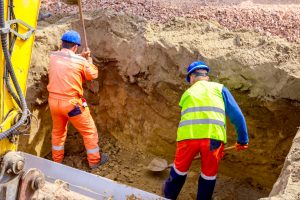Print a Sign-In Sheet | Spanish Version Coming Soon
Employees who enter trenches and other excavations may be exposed to life-threatening hazards, such as cave-ins, falling loads, hazardous atmospheres, and hazards from mobile equipment. By following safe work practices and adhering to the Occupational Safety and Health Administration (OSHA) guidelines, these exposures can be reduced.
OSHA 1926.650 defines a trench as a narrow excavation below the surface of the ground. In general, the depth is greater than the width.
OSHA Standards require that trenches and protective systems be inspected daily before work begins and after condition-changing events, such as heavy rain, water intrusion, or excessive vibration from equipment.
A competent person is an employee who has Training, Experience, and Authority to identify hazards, make changes, or stop work if needed. (Remember the TEA acronym (Training, Experience, Authority).
Safety measures:
- Know where underground utilities are prior to digging.
- Trenches 5 feet (1.5 meters) deep or greater require a protective system unless the excavation is made entirely in stable rock.
- If less than 5 feet deep, a competent person may determine that a protective system is not required.
- Trenches 20 feet (6.1 meters) deep or greater require that the protective system be designed by a registered professional engineer.
- Test for atmospheric hazards, such as toxic gases or low oxygen, in trenches deeper than 4 feet.
- Keep excavated soil (spoil pile) and other materials that could pose struck-by hazards at least 2 feet from trench edges.
- Keep heavy equipment and other sources of vibration away from trench edges.
- Never work under suspended loads.
- Don high-visibility clothing when working near moving vehicles and equipment.
Access and egress:
- Provide ladders in trenches deeper than 4 feet.
- Ladders must extend 3 feet beyond trench edges.
- In longer trenches, ladders must be placed every 25 feet of lateral travel.
- If catwalks or walkways are used for accessing trenches, fall protection guidelines apply when higher than 6 feet.
Protective systems for trenches:
- SLOPE or bench trench walls by cutting back the trench wall at an angle inclined away from the excavation. (Benching cannot be performed in Class C soil.)
- SHORE trench walls by installing aluminum hydraulic or other types of supports to prevent soil movement.
- SHIELD trench walls by using trench boxes or other types of supports to prevent soil cave-ins.
KEMI does not assume liability for the content of information contained herein. Safety and health remain your responsibility. This information is to be used for informational purposes only and not intended to be exhaustive or a substitute for proper training, supervision, or manufacturers’ instructions/recommendations. KEMI, by publication of this information, does not assume liability for damage or injury arising from reliance upon it. Compliance with this information is not a guarantee or warranty that you will be in conformity with any laws or regulations nor does it ensure the absolute safety of any person, place, or object, including, but not limited to, you, your occupation, employees, customers, or place of business.

